高三英语分词作状语知识点整理
- 格式:doc
- 大小:26.50 KB
- 文档页数:4

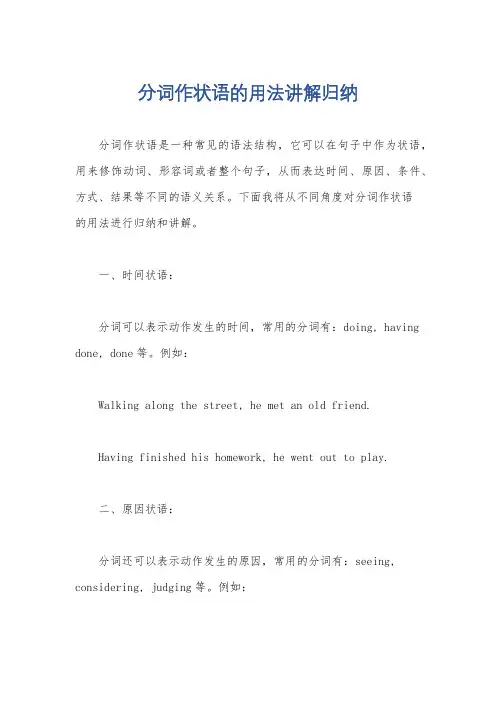
分词作状语的用法讲解归纳分词作状语是一种常见的语法结构,它可以在句子中作为状语,用来修饰动词、形容词或者整个句子,从而表达时间、原因、条件、方式、结果等不同的语义关系。
下面我将从不同角度对分词作状语的用法进行归纳和讲解。
一、时间状语:分词可以表示动作发生的时间,常用的分词有:doing, having done, done等。
例如:Walking along the street, he met an old friend.Having finished his homework, he went out to play.二、原因状语:分词还可以表示动作发生的原因,常用的分词有:seeing, considering, judging等。
例如:Seeing the heavy rain, she decided to stay at home.Considering the bad weather, we canceled the picnic.三、条件状语:分词还可以表示动作发生的条件,常用的分词有:supposing, provided, given等。
例如:Supposing the weather is fine, we will go for a picnic.Provided that you finish your work, you can go out to play.四、方式状语:分词还可以表示动作发生的方式,常用的分词有:speaking, running, working等。
例如:He ran to catch the bus, panting heavily.She answered the question, smiling brightly.五、结果状语:分词还可以表示动作的结果,常用的分词有:surprised, pleased, excited等。
例如:The news, surprising everyone, spread quickly.The children, pleased with the gifts, thanked their parents.总结起来,分词作状语的用法非常灵活多样,可以用来表示时间、原因、条件、方式和结果等不同的语义关系,丰富了句子的表达方式。
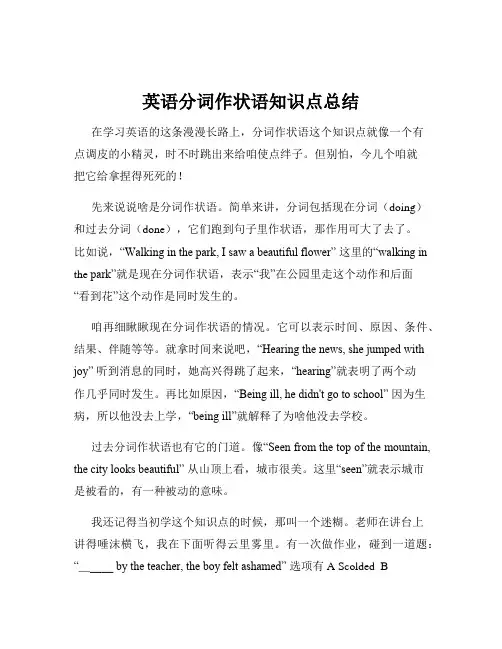
英语分词作状语知识点总结在学习英语的这条漫漫长路上,分词作状语这个知识点就像一个有点调皮的小精灵,时不时跳出来给咱使点绊子。
但别怕,今儿个咱就把它给拿捏得死死的!先来说说啥是分词作状语。
简单来讲,分词包括现在分词(doing)和过去分词(done),它们跑到句子里作状语,那作用可大了去了。
比如说,“Walking in the park, I saw a beautiful flower” 这里的“walking in the park”就是现在分词作状语,表示“我”在公园里走这个动作和后面“看到花”这个动作是同时发生的。
咱再细瞅瞅现在分词作状语的情况。
它可以表示时间、原因、条件、结果、伴随等等。
就拿时间来说吧,“Hearing the news, she jumped with joy” 听到消息的同时,她高兴得跳了起来,“hearing”就表明了两个动作几乎同时发生。
再比如原因,“Being ill, he didn't go to school” 因为生病,所以他没去上学,“being ill”就解释了为啥他没去学校。
过去分词作状语也有它的门道。
像“Seen from the top of the mountain, the city looks beautiful” 从山顶上看,城市很美。
这里“seen”就表示城市是被看的,有一种被动的意味。
我还记得当初学这个知识点的时候,那叫一个迷糊。
老师在讲台上讲得唾沫横飞,我在下面听得云里雾里。
有一次做作业,碰到一道题:“_____ by the teacher, the boy felt ashamed” 选项有 A Scolded BScolding C To scold D Having scolded 。
我瞅了半天,心里那个纠结啊,感觉每个选项都好像对又好像不对。
最后一咬牙,选了个 B,结果当然是错得一塌糊涂。
老师把我叫到办公室,耐心地给我讲解:“这道题是过去分词作状语,表示被动,被老师批评,所以应该选 A 呀。
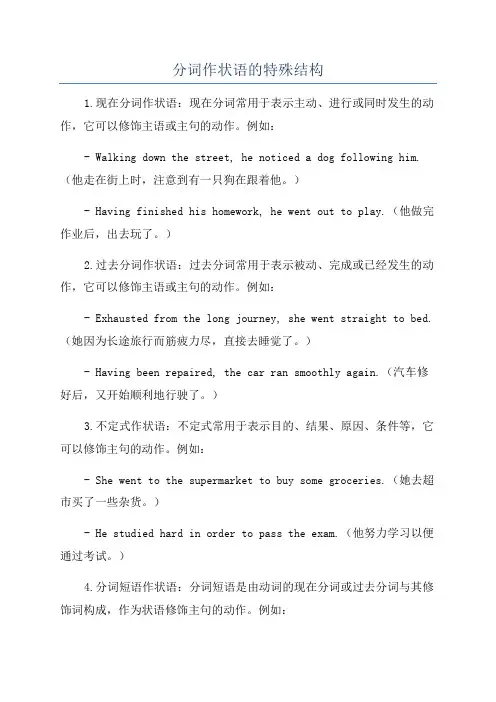
分词作状语的特殊结构1.现在分词作状语:现在分词常用于表示主动、进行或同时发生的动作,它可以修饰主语或主句的动作。
例如:- Walking down the street, he noticed a dog following him.(他走在街上时,注意到有一只狗在跟着他。
)- Having finished his homework, he went out to play.(他做完作业后,出去玩了。
)2.过去分词作状语:过去分词常用于表示被动、完成或已经发生的动作,它可以修饰主语或主句的动作。
例如:- Exhausted from the long journey, she went straight to bed.(她因为长途旅行而筋疲力尽,直接去睡觉了。
)- Having been repaired, the car ran smoothly again.(汽车修好后,又开始顺利地行驶了。
)3.不定式作状语:不定式常用于表示目的、结果、原因、条件等,它可以修饰主句的动作。
例如:- She went to the supermarket to buy some groceries.(她去超市买了一些杂货。
)- He studied hard in order to pass the exam.(他努力学习以便通过考试。
)4.分词短语作状语:分词短语是由动词的现在分词或过去分词与其修饰词构成,作为状语修饰主句的动作。
例如:- The boy ran into the room, crying loudly.(那个男孩跑进房间,大声哭着。
)- The car skidded on the wet road, causing an accident.(汽车在湿滑的路上打滑,导致了一起事故。
)这些特殊结构的分词作状语可以增加句子的信息量,使句子更加丰富和生动。
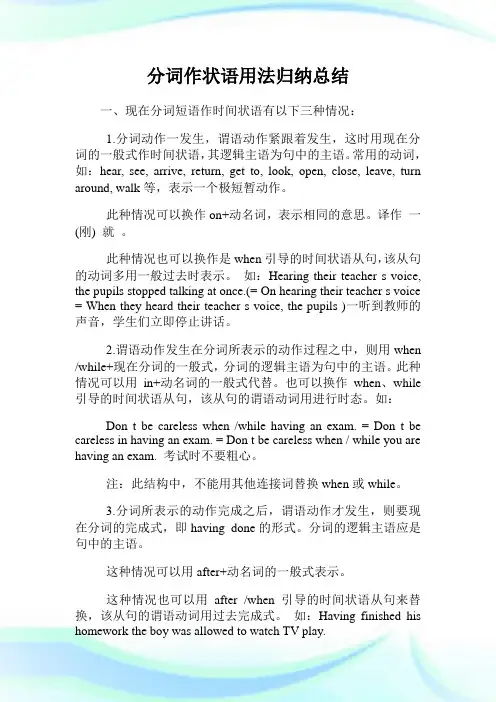
分词作状语用法归纳总结一、现在分词短语作时间状语有以下三种情况:1.分词动作一发生,谓语动作紧跟着发生,这时用现在分词的一般式作时间状语,其逻辑主语为句中的主语。
常用的动词,如:hear, see, arrive, return, get to, look, open, close, leave, turn around, walk等,表示一个极短暂动作。
此种情况可以换作on+动名词,表示相同的意思。
译作一(刚) 就。
此种情况也可以换作是when引导的时间状语从句,该从句的动词多用一般过去时表示。
如:Hearing their teacher s voice, the pupils stopped talking at once.(= On hearing their teacher s voice = When they heard their teacher s voice, the pupils )一听到教师的声音,学生们立即停止讲话。
2.谓语动作发生在分词所表示的动作过程之中,则用when /while+现在分词的一般式,分词的逻辑主语为句中的主语。
此种情况可以用in+动名词的一般式代替。
也可以换作when、while 引导的时间状语从句,该从句的谓语动词用进行时态。
如:Don t be careless when /while having an exam. = Don t be careless in having an exam. = Don t be careless when / while you are having an exam. 考试时不要粗心。
注:此结构中,不能用其他连接词替换when或while。
3.分词所表示的动作完成之后,谓语动作才发生,则要现在分词的完成式,即having done的形式。
分词的逻辑主语应是句中的主语。
这种情况可以用after+动名词的一般式表示。
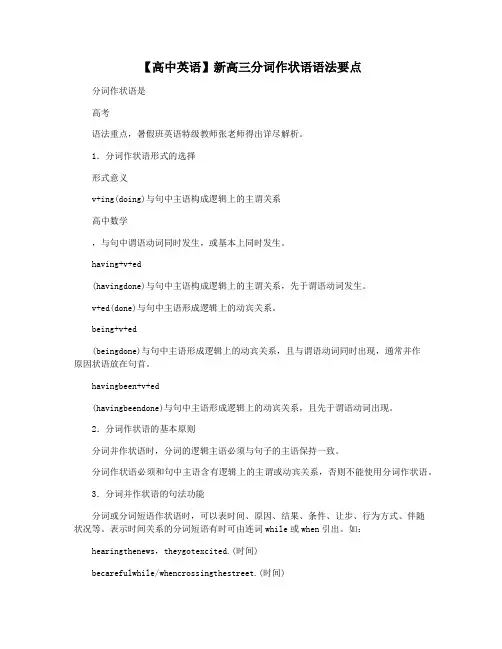
【高中英语】新高三分词作状语语法要点分词作状语是高考语法重点,暑假班英语特级教师张老师得出详尽解析。
1.分词作状语形式的选择形式意义v+ing(doing)与句中主语构成逻辑上的主谓关系高中数学,与句中谓语动词同时发生,或基本上同时发生。
having+v+ed(havingdone)与句中主语构成逻辑上的主谓关系,先于谓语动词发生。
v+ed(done)与句中主语形成逻辑上的动宾关系。
being+v+ed(beingdone)与句中主语形成逻辑上的动宾关系,且与谓语动词同时出现,通常并作原因状语放在句首。
havingbeen+v+ed(havingbeendone)与句中主语形成逻辑上的动宾关系,且先于谓语动词出现。
2.分词作状语的基本原则分词并作状语时,分词的逻辑主语必须与句子的主语保持一致。
分词作状语必须和句中主语含有逻辑上的主谓或动宾关系,否则不能使用分词作状语。
3.分词并作状语的句法功能分词或分词短语作状语时,可以表时间、原因、结果、条件、让步、行为方式、伴随状况等。
表示时间关系的分词短语有时可由连词while或when引出。
如:hearingthenews,theygotexcited.(时间)becarefulwhile/whencrossingthestreet.(时间)havingbeenbittenbyasnake,shewasfrightenedatit.(原因)givenachance,icansurprisetheworld.(条件)thecupdroppedtotheground,breakingintopieces.(结果)havingbeentoldmanytimes,hestillrepeatedthesamemistake.(让步)theteachercameintothelab,followedbysomestudents.(充斥状况)4.独立成分作状语有些分词短语,其形式的挑选不受到上下文的影响,称为单一制成分。
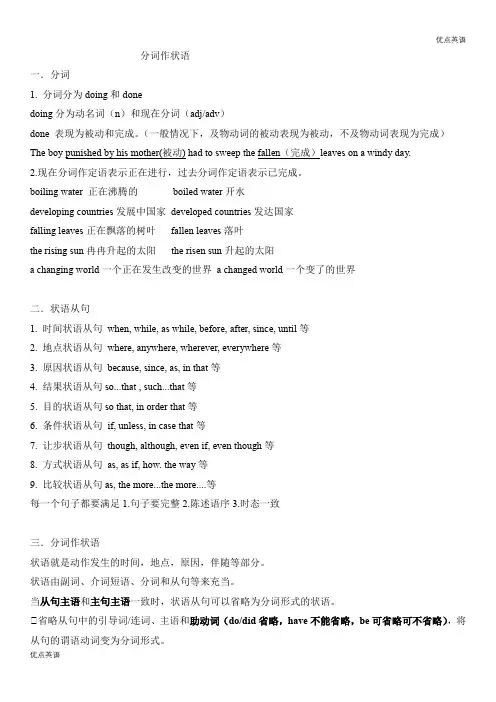
分词作状语一.分词1. 分词分为doing和donedoing分为动名词(n)和现在分词(adj/adv)done 表现为被动和完成。
(一般情况下,及物动词的被动表现为被动,不及物动词表现为完成)The boy punished by his mother(被动) had to sweep the fallen(完成)leaves on a windy day.2.现在分词作定语表示正在进行,过去分词作定语表示已完成。
boiling water 正在沸腾的boiled water开水developing countries发展中国家developed countries发达国家falling leaves正在飘落的树叶fallen leaves落叶the rising sun冉冉升起的太阳the risen sun升起的太阳a changing world一个正在发生改变的世界a changed world一个变了的世界二.状语从句1. 时间状语从句when, while, as while, before, after, since, until等2. 地点状语从句where, anywhere, wherever, everywhere等3. 原因状语从句because, since, as, in that等4. 结果状语从句so...that , such...that等5. 目的状语从句so that, in order that等6. 条件状语从句if, unless, in case that等7. 让步状语从句though, although, even if, even though等8. 方式状语从句as, as if, how. the way等9. 比较状语从句as, the more...the more....等每一个句子都要满足1.句子要完整2.陈述语序3.时态一致三.分词作状语状语就是动作发生的时间,地点,原因,伴随等部分。
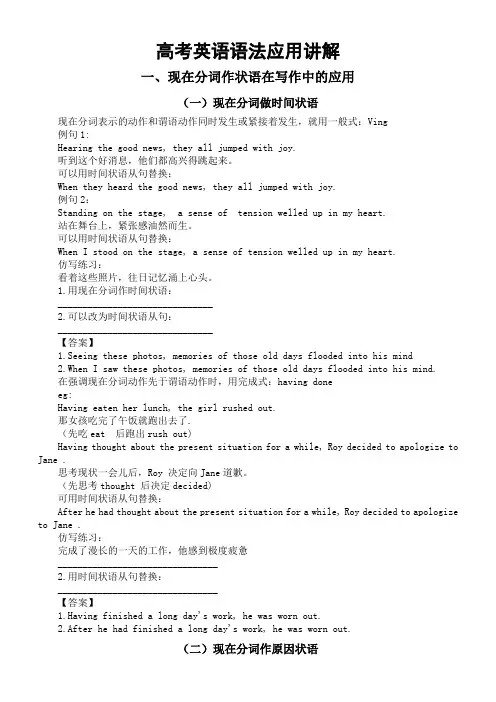
高考英语语法应用讲解一、现在分词作状语在写作中的应用(一)现在分词做时间状语现在分词表示的动作和谓语动作同时发生或紧接着发生,就用一般式:Ving例句1:Hearing the good news, they all jumped with joy.听到这个好消息,他们都高兴得跳起来。
可以用时间状语从句替换:When they heard the good news, they all jumped with joy.例句2:Standing on the stage, a sense of tension welled up in my heart.站在舞台上,紧张感油然而生。
可以用时间状语从句替换:When I stood on the stage, a sense of tension welled up in my heart.仿写练习:看着这些照片,往日记忆涌上心头。
1.用现在分词作时间状语:_______________________________2.可以改为时间状语从句:_______________________________【答案】1.Seeing these photos, memories of those old days flooded into his mind2.When I saw these photos, memories of those old days flooded into his mind.在强调现在分词动作先于谓语动作时,用完成式:having doneeg:Having eaten her lunch, the girl rushed out.那女孩吃完了午饭就跑出去了.(先吃eat 后跑出rush out)Having thought about the present situation for a while, Roy decided to apologize to Jane .思考现状一会儿后,Roy 决定向Jane道歉。
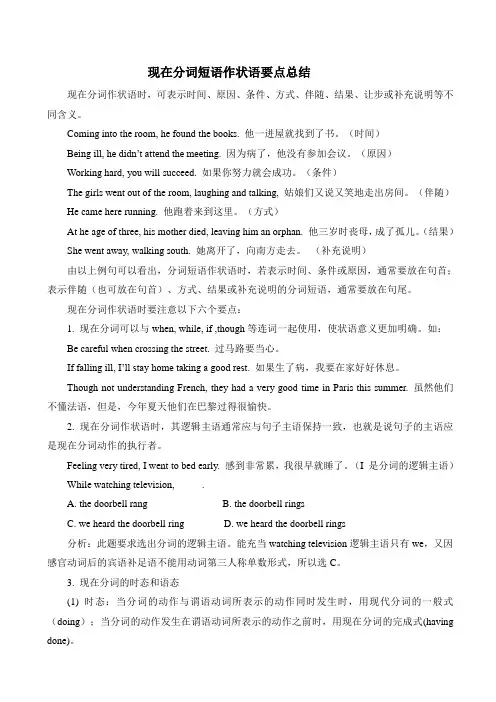
现在分词短语作状语要点总结现在分词作状语时,可表示时间、原因、条件、方式、伴随、结果、让步或补充说明等不同含义。
Coming into the room, he found the books. 他一进屋就找到了书。
(时间)Being ill, he didn’t attend the meeting. 因为病了,他没有参加会议。
(原因)Working hard, you will succeed. 如果你努力就会成功。
(条件)The girls went out of the room, laughing and talking, 姑娘们又说又笑地走出房间。
(伴随)He came here running. 他跑着来到这里。
(方式)At he age of three, his mother died, leaving him an orphan. 他三岁时丧母,成了孤儿。
(结果)She went away, walking south. 她离开了,向南方走去。
(补充说明)由以上例句可以看出,分词短语作状语时,若表示时间、条件或原因,通常要放在句首;表示伴随(也可放在句首)、方式、结果或补充说明的分词短语,通常要放在句尾。
现在分词作状语时要注意以下六个要点:1. 现在分词可以与when, while, if ,though等连词一起使用,使状语意义更加明确。
如:Be careful when crossing the street. 过马路要当心。
If falling ill, I’ll stay home taking a good rest. 如果生了病,我要在家好好休息。
Though not understanding French, they had a very good time in Paris this summer. 虽然他们不懂法语,但是,今年夏天他们在巴黎过得很愉快。
2. 现在分词作状语时,其逻辑主语通常应与句子主语保持一致,也就是说句子的主语应是现在分词动作的执行者。
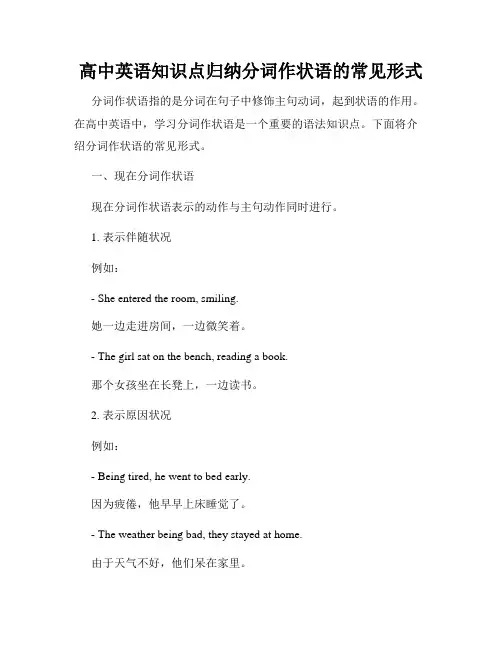
高中英语知识点归纳分词作状语的常见形式分词作状语指的是分词在句子中修饰主句动词,起到状语的作用。
在高中英语中,学习分词作状语是一个重要的语法知识点。
下面将介绍分词作状语的常见形式。
一、现在分词作状语现在分词作状语表示的动作与主句动作同时进行。
1. 表示伴随状况例如:- She entered the room, smiling.她一边走进房间,一边微笑着。
- The girl sat on the bench, reading a book.那个女孩坐在长凳上,一边读书。
2. 表示原因状况例如:- Being tired, he went to bed early.因为疲倦,他早早上床睡觉了。
- The weather being bad, they stayed at home.由于天气不好,他们呆在家里。
3. 表示条件状况例如:- I will go to the park, weather permitting.天气允许的话,我会去公园。
- We went out, the rain having stopped.雨停了,我们出去了。
4. 表示方式、手段状况例如:- He ran to the bus stop, hoping to catch the bus.他跑到公交车站,希望能赶上公交车。
- The boy solved the math problem, using the formula he had learned.这个男孩用他学过的公式解了这个数学问题。
二、过去分词作状语过去分词作状语表示的动作发生在主句动作之前。
1. 表示时间状况例如:- Having finished his homework, he went out to play.他完成了作业后,出去玩了。
- We arrived at the airport, having missed the flight.我们到达机场时,航班已经错过了。

高中英语知识点归纳状语的分类及用法英语中的状语(Adverbial)是表示动作、情态、时间、地点、方式、原因、目的等的修饰成分,状语可通过不同的形式来表达,如副词、介词短语、从句等。
下面是高中英语知识点归纳状语的分类及用法的详细内容。
一、时间状语(Adverbial of Time)描述动作发生的具体时间或时间段。
1. 副词形式的时间状语:今天(today)、明天(tomorrow)、昨天(yesterday)、现在(now)、过去(past)、将来(future)等。
例如:He will travel to Japan next week.翻译:他下个星期会去日本旅行。
2. 介词短语形式的时间状语:at(在……时刻)、on(在……日子)、in(在……时间段)等。
例如:She usually goes to the gym in the evening.翻译:她通常晚上去健身房。
3. 从句形式的时间状语:when(当……时候)、while(当……时候)、before(在……之前)、after(在……之后)等。
例如:I will call you when I arrive.翻译:我到达时会给你打电话。
二、地点状语(Adverbial of Place)描述动作发生的具体地点或场所。
1. 副词形式的地点状语:here(这里)、there(那里)、everywhere(到处)、somewhere (某处)等。
例如:The cat is hiding under the table.翻译:猫躲在桌子下面。
2. 介词短语形式的地点状语:in(在……里)、on(在……上)、at(在……处)等。
例如:The book is on the shelf.翻译:这本书在书架上。
3. 从句形式的地点状语:where(在哪里)、wherever(无论在哪里)等。
例如:Please tell me where you live.翻译:请告诉我你住在哪里。
V-ing (现在分词)作状语v-ed/done(过去分词)作状语,表语,定语,宾补一.现在分词的形式形式主动形式被动形式否定形式一般式doing beingdone not doing/beingdone完成式havingdone having been done not having(been)done二.现在分词作状语辨析:动词的-ing 形式和动词不定式作结果状语的区别。
辨析:(1)动词的-ing 形式作结果状语通常表示自然而然的结果。
(2)动词不定式作结果状语通常表示意想不到的结果,常与only 连用,构成“only to do sth.”三.连词+动词的-ing 形式作状语,省略状语从句的主语和系动词be ,表示主动或者正在句子功能例句1.作时间状语,相当于when,while,as,after 等引导的时间状语从句Crossing the road,the old man was knocked over by a car.=When he was crossing the road,the old man was knocked over by a car.2.作原因状语,相当于as,because,since 等引导的原因状语从句Having eaten too much ,he couldn 't go to sleep.=Because he had eaten too much,he couldn't go to sleep.3.作条件状语,相当于if,once,unless 等引导的条件状语从句Using your head,you 'll find a good way.=If you use your head,you'll find a good way.4.作方式或伴随状语,相当于and 连接的并列谓语动词。
Four people entered the room looking around in a curious way.=Four people entered the room and looked around in a curious way.5.作结果状语,可扩展为有并列谓语的句子。
分词作状语用法知识点详解和辨析_分词作状语用法知识点分词做状语,在我们的英语表达里有何用法与见解呢?下面是小编为大家整理的关于分词作状语用法知识点详解和辨析_分词作状语用法知识点,希望对您有所帮助。
欢迎大家阅读参考学习!目录英语分词的形式非谓语动词主动形式被动形式意义现在分词一般式doing being done与句中谓语动作几乎同时发生完成式having donehaving been done先于句中谓语动作发生,强调时间先后过去分词done-----------------与句中主语为逻辑上的被动,表完成英语分词的意义在英语中,分词包括现在分词与过去分词两种形式,即“-ing”与“-ed”。
一般情况下,从时态和语态两种角度来讲,现在分词表示主动、进行;而过去分词表示被动与完成。
对于分词的含义,我们从以下两组词语为例进行分析:1)the sinking ship 正在下沉的船 & falling leaves 正在飘落的树叶2)the sunken ship 已经沉底的船 & fallen leaves 落在地上的树叶 \ the boiled water 凉白开水1)从语态角度来看,现在分词表示主动含义,它与所修饰的名词构成主谓关系。
the sinking ship 可以改写为the ship that is\ was sinking, 这里的ship相当于sink的逻辑主语。
其次,从时态角度看,现在分词一般表示进行的动作,相当于一个进行时态;此外,它还可以表示一般的动作,相当于一个一般的时态。
综上,现在分词的意义有两种:主动进行的动作和主动一般的动作。
2)从语态角度来看,过去分词可以表示被动含义也可以表示主动含义,即动词不同则含义不同。
及物动词的过去分词只有被动含义,如the boiled water=the water that was boiled \ the water that has been boiled. 而不及物动词没有被动只有主动,如the sunken ship= the ship that has sunken.但是不及物动词的过去分词出现频率较低,常见的过去分词多为及物动词的过去分词,表达被动含义。
高中英语知识点归纳非谓语动词作状语非谓语动词作状语是高中英语的重要知识点之一。
非谓语动词包括不定式、动名词和分词,它们可以在句子中充当状语,用来修饰动词、形容词或副词,起到说明动作、表达原因、目的、结果、条件等作用。
下面是对非谓语动词作状语的归纳总结。
一、不定式作状语不定式作状语可以表示目的、结果、原因、条件等。
常见的结构有:1. 目的状语:She went to the supermarket to buy some vegetables.她去超市买蔬菜。
2. 结果状语:He studied hard to pass the exam.他努力学习以通过考试。
3. 原因状语:He hurried home to avoid the rain.他匆忙回家以避雨。
4. 条件状语:To solve the problem, we need to work together.为了解决这个问题,我们需要共同努力。
二、动名词作状语动名词作状语可以表示目的、结果、原因、时间、方式等。
常见的结构有:1. 目的状语:He practices playing the piano every day to improve his skills.他每天练习弹钢琴以提高技能。
2. 结果状语:She couldn't sleep, feeling worried about the exam.她无法入睡,对考试感到担忧。
3. 原因状语:They raised their voices, shouting for help.他们提高了声音,呼救。
4. 时间状语:Walking along the street, I saw an old friend of mine.走在街上的时候,我碰见了一个老朋友。
5. 方式状语:He solved the math problem by using a different method.他用不同的方法解决了这个数学问题。
高三英语分词作状语知识点整理
为同学们整理了高三英语分词作状语知识点整理。
希望对考生在备考中有所帮助,欢迎大家阅读作为参考。
难点形成原因:
1. 对在句中作时间、条件、原因还是别的状语不是很清楚。
2.分不清何时用现在分词、何时用过去分词。
解决办法:
1.理解分词作状语时可以转换成相应的状语从句。
2.分清何时用现在分词、何时用过去分词。
用法讲解:
1. 分词或分词短语作状语时,可以表示时间、原因、让步、条件,方式或伴随状况。
通常可转换成相应的状语从句;表示方式或伴随状况时可以转换成并列句或非限制性定语从句。
例如:
Put into use in April 2000 (=When it was put into use in April 2000), the hotline was meant for residents reporting water and heating supply breakdowns. 分词短语作时间状语
Blamed for the breakdown of the school computer
network (=Because she was blamed for the breakdown of the school computer network), Alice was in low spirits. 分词短语作原因状语
Given time (=If he is given time), hell make a fist-class tennis player. 分词短语作条件状语 We often provide our children with toys, footballs or basketballs, thinking that all children like these things. (= and think that all children like these things.) 分词短语作伴随状语
2. 有时为了强调,分词前可带when, while, if, though, as if, unless等连词一起作状语,以便使句子的意思更清楚、更连贯。
例如:
When comparing different cultures, we often pay attention only to the differences without noticing the many similarities.
Though tired, he still continued reading.
3. 现在分词和过去分词作状语时的用法比较。
不管是现在分词还是过去分词单独作状语,其逻辑主语必须与主句的主语一致。
分词作状语通常可转换成一个相应的状语从句或并列句,如果状语分句或并列句中的谓语动词为被动结构,就用过去分词;如果状语分句或并列句中的谓语动词为主动结构,就用现在分词。
例如:
When compared with the size of the whole earth , the biggest ocean does not seem big at all.
分词部分相当于When the biggest ocean is compared with the size of the whole earth, 主语与分词是被动关系,所以用过去分词。
When comparing it with the size of the whole earth, we find that the biggest ocean does not seem big at all.
When we compare it with the size of the whole earth... 主语与分词是主动关系, 所以用现在分词。
Faced with a bill for$10,000(=Because he is faced with a bill for$10,000), John has taken an extra job.
Whenever he was asked why he was late for class, he would answer carelessly, always saying the same thing (= and he would say the same thing).
注意:
1. 现在分词有两种时态:一般式doing和完成式having done。
一般式通常表示与主句的谓语动词所表示的
动作同时发生或无先后;完成式则强调分词所表示的动作先
于谓语动词所表示的动作。
如:
While walking in the street, we met some friends of ours.(同时发生)
Having waited in the queue for half an hour, Tom
suddenly realized that he had left his wallet at home. (“等待”先于谓语动词“意识到”)
2. 分词的否定式的构成: not +分词。
Not having received a reply, he decided to write again.。